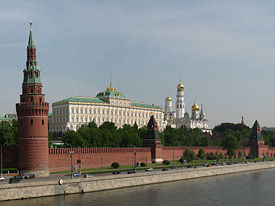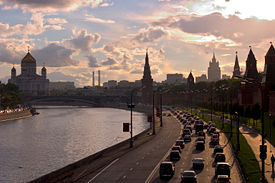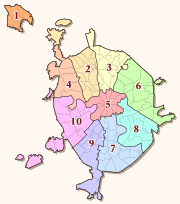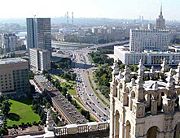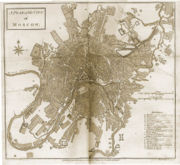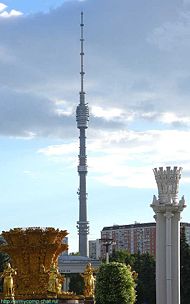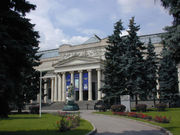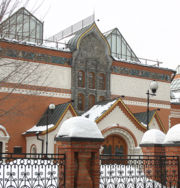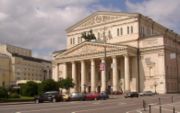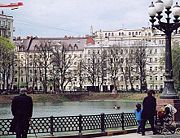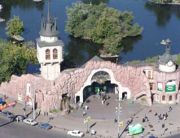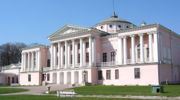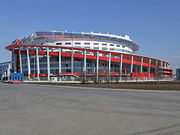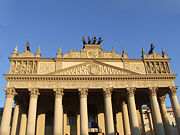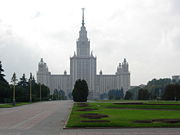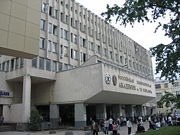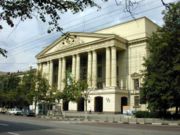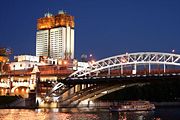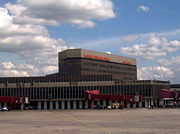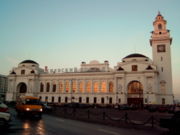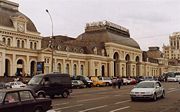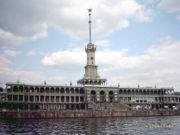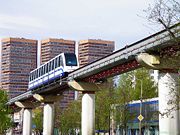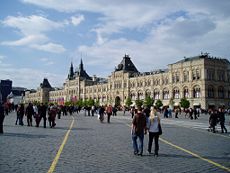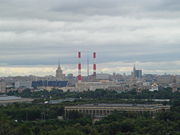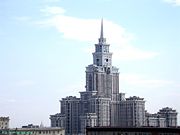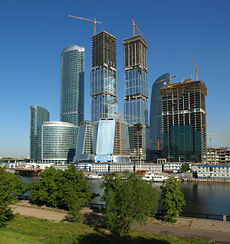Moscow
2008/9 Schools Wikipedia Selection. Related subjects: Geography of Asia
| Moscow (English) Москва (Russian) |
|
|---|---|
 Red Square |
|
 Location of Moscow in Europe |
|
| Coordinates Coordinates: |
|
| Coat of Arms | Flag |
 |
 |
| Political status Federal district Economic region |
Federal city Central Central |
| Code | 77 |
| Area | |
| Area | 1,081 km² (417.4 sq mi) |
| Population (as of the 2002 Census) | |
| Population - Rank - Density |
10,382,754 inhabitants 1st 9,604.8/km² (24,876.3/sq mi) |
| Government | |
| Head | Yury Luzhkov |
| Legislative body | City Duma |
| Charter | Charter of Moscow |
| Events | |
| Founded | 1147 |
| Other information | |
| Postal code | 101xxx–129xxx |
| Dialing codes | +7 495, +7 499 |
| Official website | |
| http://www.mos.ru | |
Moscow (Russian: Москва́, romanised: Moskvá, IPA: [mɐˈskva] see also other names) is the capital and the largest city of Russia, and the largest city in Europe, with its metropolitan area ranking among the largest urban areas in the world. Moscow is the country's political, economic, religious, financial, educational and transportation centre. It is located on the Moskva River in the Central Federal District, in the European part of Russia. Historically, it was the capital of the former Soviet Union and the Grand Duchy of Moscow, the pre-Imperial Russian state. It is the site of the Moscow Kremlin, which serves as the ceremonial residence of the President of Russia. Moscow is a major economic centre and is home to the largest number of billionaires in the world; in 2007 Moscow was named the world's most expensive city for the second year in a row. It is home to many scientific and educational institutions, as well as numerous sport facilities. It possesses a complex transport system, which is famous for its architecture and artwork.
History
The city is named after the river (old Russian: гра́д Моско́в, literally "the city by the Moskva River"). The origin of the name is unknown, although several theories exist. One theory suggests that the source of the name is an ancient Finnic language, in which it means “dark” and “turbid”. The first Russian reference to Moscow dates from 1147 when Yuri Dolgoruki called upon the prince of the Novgorod Republic to “come to me, brother, to Moscow.”
Nine years later, in 1156, Prince Yuri Dolgoruki of Rostov ordered the construction of a wooden wall, which had to be rebuilt multiple times, to surround the emerging city. After the sacking of 1237–1238, when the Mongols burned the city to the ground and killed its inhabitants, Moscow recovered and became the capital of an independent principality in 1327. Its favourable position on the headwaters of the Volga River contributed to steady expansion. Moscow developed into a stable and prosperous principality for many years and attracted a large number of refugees from across Russia.
Under Ivan I, the city replaced Tver as a political centre of Vladimir-Suzdal and became the sole collector of taxes for the Mongol-Tatar rulers. By paying high tribute, Ivan won an important concession from the Khan. Unlike other principalities, Moscow was not divided among his sons but was passed intact to his eldest. However, Moscow's opposition against foreign domination grew. In 1380, prince Dmitri Donskoi of Moscow led a united Russian army to an important victory over the Tatars in the Battle of Kulikovo which was not decisive, though. Only two years later Moscow was sacked by khan Tokhtamysh. In 1480, Ivan III had finally broken the Russians free from Tatar control, allowing Moscow to become the centre of power in Russia. Under Ivan III the city became the capital of an empire that would eventually encompass all of present-day Russia and other lands.
In 1571, the Crimean Tatars attacked and sacked Moscow, burning everything but the Kremlin.
In 1609, the Swedish army led by Count Jacob De la Gardie and Evert Horn started their march from Velikiy Novgorod toward Moscow to help Tsar Vasili Shuiski, entered Moscow in 1610 and suppressed the rebellion against the Tsar, but leaving it early next year 1611, following which the Polish-Lithuanian army invaded.
The 17th century was rich in popular risings, such as the liberation of Moscow from the Polish-Lithuanian invaders (1612), the Salt Riot (1648), the Copper Riot (1662), and the Moscow Uprising of 1682.
The plague of 1654–1656 had killed half the population of Moscow. The city ceased to be Russia’s capital in 1712, after the founding of Saint Petersburg by Peter the Great on the Baltic coast in 1703. When Napoleon invaded Russia in 1812, the Muscovites burned the city and evacuated, as Napoleon’s forces were approaching on 14 September. Napoleon’s army, plagued by hunger, cold and poor supply lines, was forced to retreat and was nearly annihilated by the devastating Russian winter and sporadic attacks by Russian military forces.
In January 1905, the institution of the City Governor, or Mayor, was officially introduced in Moscow, and Alexander Adrianov became Moscow’s first official mayor. Following the Russian Revolution of 1917, on March 12, 1918, Moscow became the capital of the Russian Soviet Federative Socialist Republic and the Soviet Union less than five years later. During the Great Patriotic War (a part of World War II and the official Russian name for the conflict, after German invasion of the USSR), the Soviet State Committee of Defence and the General Staff of the Red Army was located in Moscow.
In 1941, sixteen divisions of the national volunteers (more than 160,000 people), twenty-five battalions (18,500 people) and four engineering regiments were formed among the Muscovites. That November, the German Army Group Centre was stopped at the outskirts of the city and then driven off in the course of the Battle of Moscow. Many factories were evacuated, together with much of the government, and from October 20 the city was declared to be under siege. Its remaining inhabitants built and manned antitank defences, while the city was bombarded from the air. It is of some note that Stalin refused to leave the city, meaning the general staff and the council of people's commissars remained in the city as well. Despite the siege and the bombings, the construction of Moscow's metro system, continued through the war and by the end of the war several new metro lines were opened.
On May 1, 1944, a medal For the defence of Moscow and in 1947 another medal In memory of the 800th anniversary of Moscow were instituted.
In commemoration of the 20th anniversary of the victory in World War II, on May 8, 1965, Moscow was one of twelve Soviet cities awarded the title of the Hero City. In 1980, it hosted the Summer Olympic Games, which was boycotted by the United States and several other Western countries due to the Soviet Union's invasion of Afghanistan in late 1979.
In 1991, Moscow was the scene of a coup attempt by the government members opposed to the reforms of Mikhail Gorbachev. When the USSR was dissolved in the same year, Moscow continued to be the capital of Russia.
Since then, the emergence of a market economy in Moscow has produced an explosion of Western-style retailing, services, architecture, and lifestyles. Besides the historical traits of Moscow, it has many different agricultural attributes. In 1998, it hosted the first World Youth Games. Moscow is the seat of power for the Russian Federation. At the centre of the city, in Central Administrative Okrug, is the Moscow Kremlin, which houses the home of the President of Russia as well as many of the facilities for the national government. This includes numerous military headquarters and the headquarters of the Moscow Military District.
Moscow, like with any national capital, is also the host of all the foreign embassies and diplomats representing a multitude of nations in Russia. Moscow is designated as one of only two Federal cities of Russia (the other one being Saint Petersburg). Among the 85 Federal subjects of Russia, Moscow represents the most populated one and the smallest one in terms of area. Lastly, Moscow is located within the central economic region, one of twelve regions within Russia with similar economic goals.
The entire city of Moscow is headed by one mayor ( Yuriy Luzhkov). It is divided into ten administrative okrugs and 123 districts. Nine of the ten administrative districts, except the City of Zelenograd (number 1 on the map), are located within City of Moscow main boundaries. All administrative okrugs and districts have their own coats of arms, flags, and elected head officials. Additionally, most districts have their own cable television, computer network, and official newspaper. In addition to the districts, there are Territorial Units with Special Status, or territories. These usually include areas with small or no permanent populations, such as the case with the All-Russia Exhibition Centre, the Botanical Garden, large parks, and industrial zones.
In recent years, some territories have been merged with different districts. There are no ethnic-specific regions in Moscow, as in the Chinatowns that exist in some North American and East Asian cities. And although districts are not designated by income, as with most cities, those areas that are closer to the city centre, metro stations or green zones are considered more prestigious.
Government
Moscow is the seat of power for the Russian Federation. At the centre of the city, in Central Administrative Okrug, is the Moscow Kremlin, which houses the home of the President of Russia as well as many of the facilities for the national government. This includes numerous military headquarters and the headquarters of the Moscow Military District. Moscow, like with any national capital, is also the host of all the foreign embassies and diplomats representing a multitude of nations in Russia. Moscow is designated as one of only two Federal cities of Russia (the other one being Saint Petersburg). Among the 83 federal subjects of Russia, Moscow represents the most populated one and the smallest one in terms of area. Lastly, Moscow is located within the central economic region, one of twelve regions within Russia with similar economic goals.
The entire city of Moscow is headed by one mayor ( Yuriy Luzhkov). It is divided into ten administrative okrugs and 123 districts. Nine of the ten administrative districts, except the City of Zelenograd (number 1 on the map), are located within City of Moscow main boundaries.
All administrative okrugs and districts have their own coats of arms, flags, and elected head officials. Additionally, most districts have their own cable television, computer network, and official newspaper.
In addition to the districts, there are Territorial Units with Special Status, or territories. These usually include areas with small or no permanent populations, such as the case with the All-Russia Exhibition Centre, the Botanical Garden, large parks, and industrial zones. In recent years, some territories have been merged with different districts. There are no ethnic-specific regions in Moscow, as in the Chinatowns that exist in some North American and East Asian cities. And although districts are not designated by income, as with most cities, those areas that are closer to the city centre, metro stations or green zones are considered more prestigious.
In addition to being the capital of Russia, Moscow is the administrative centre of Moscow Oblast. Since Moscow has the status of a federal city, it is administratively separate from the oblast.
Geography and climate
Moscow has a hemiboreal climate ( Koppen climate classification Dfb) with warm, somewhat humid summers and long, cold winters. Typical high temperatures in the warm months of June, July and August are around 22 °C (72 °F); in the winter, temperatures normally drop to approximately -10 °C (13 °F). The highest temperature ever recorded was 36.7 ℃ (98.1 ℉) in August 1998, and the lowest ever recorded was -42.2 °C in January 1940.
Monthly rainfall totals vary minimally throughout the year, although the precipitation levels tend to be higher during the summer than during the winter. Due to the significant variation in temperature between the winter and summer months as well as the limited fluctuation in precipitation levels during the summer, Moscow is considered to be within a continental climate zone.
| Weather averages for Moscow | |||||||||||||
|---|---|---|---|---|---|---|---|---|---|---|---|---|---|
| Month | Jan | Feb | Mar | Apr | May | Jun | Jul | Aug | Sep | Oct | Nov | Dec | Year |
| Record high °C (°F) | 8.6 (47) | 8.3 (47) | 17.5 (64) | 28.0 (82) | 33.2 (92) | 34.7 (94) | 36.5 (98) | 36.7 (98) | 32.3 (90) | 24.0 (75) | 12.6 (55) | 9.2 (49) | 36.7 (98) |
| Average high °C (°F) | -4.6 (24) | -3.1 (26) | 2.3 (36) | 11.1 (52) | 18.1 (65) | 22.2 (72) | 23.4 (74) | 21.4 (71) | 15.2 (59) | 8.2 (47) | 0.6 (33) | -3.0 (27) | 9.3 (49) |
| Average low °C (°F) | -10.5 (13) | -9.9 (14) | -5.0 (23) | 2.2 (36) | 7.3 (45) | 11.9 (53) | 13.6 (56) | 12.0 (54) | 6.9 (44) | 2.2 (36) | -3.9 (25) | -7.9 (18) | 1.6 (35) |
| Record low °C (°F) | -42.2 (-44) | -38.2 (-37) | -32.4 (-26) | -21.0 (-6) | -7.5 (19) | -2.3 (28) | 1.3 (34) | -1.2 (30) | -8.5 (17) | -16.1 (3) | -32.8 (-27) | -38.8 (-38) | -42.2 (-44) |
| Precipitation mm (inches) | 42 (1.65) | 36 (1.42) | 34 (1.34) | 44 (1.73) | 51 (2.01) | 75 (2.95) | 94 (3.7) | 77 (3.03) | 65 (2.56) | 59 (2.32) | 58 (2.28) | 56 (2.2) | 691 (27.2) |
| Source: Pogoda.ru.net 7.09.2007 | |||||||||||||
Moscow is situated on the banks of the Moskva River, which flows for just over 500 km through the East European Plain in central Russia. 49 bridges span the river and its canals within the city's limits.
Moscow's road system is centered roughly around the Kremlin at the heart of the city. From there, roads generally radiate outwards to intersect with a sequence of circular roads (“rings”).
The first and innermost major ring, Bulvarnoye Koltso ( Boulevard Ring), was built at the former location of the sixteenth century city wall around that used to be called Bely Gorod (White Town). The Bulvarnoye Koltso is technically not a ring; it does not form a complete circle, but instead a horseshoe-like arc that goes from the Cathedral of Christ the Saviour to the Yauza River. In addition, the Boulevard Ring changes street names numerous times throughout its journey across the city.
The second primary ring, located outside the Boulevard Ring, is the Sadovoye Koltso ( Garden Ring). Like the Boulevard Ring, the Garden Ring follows the path of a sixteenth century wall that used to encompass part of the city. The third ring, the Third Transport Ring, was completed in 2003 as a high-speed freeway. The Fourth Transport Ring, another freeway, is under construction to further reduce traffic congestion. The outermost ring within Moscow is the Moscow Automobile Ring Road (often called the MKAD from the Russian Московская Кольцевая Автомобильная Дорога), which forms the approximate boundary of the city.
Outside the city, some of the roads encompassing the city continue to follow this circular pattern seen inside city limits.
Architecture
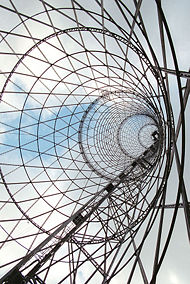
Moscow’s architecture is world-renowned. Moscow is also well known as the site of Saint Basil’s Cathedral, with its elegant onion domes, as well as the Cathedral of Christ the Savior and the Seven Sisters. The Patriarch of Moscow, whose residence is the Danilov Monastery, serves as the head of the Orthodox Church. Moscow also hosted the 1980 Summer Olympics. For a long time, the view of the city was dominated by numerous Orthodox churches. The look of the city changed drastically during Soviet times, mostly due to Joseph Stalin, who oversaw a large-scale effort to modernise the city. He introduced broad avenues and roadways, some of them over ten lanes wide, but he also destroyed a great number of historically significant architectural works. The Sukharev Tower, as well as numerous mansions and stores lining the major streets, and various works of religious architecture, such as the Kazan Cathedral and the Cathedral of Christ the Saviour, were all destroyed during Stalin’s rule. During the 1990s, however, both the latter were rebuilt amid criticism due to the high costs and lack of historical perspective.
Architect Vladimir Shukhov was responsible for building several of Moscow’s landmarks during early Soviet Russia. The Shukhov Tower, just one of many hyperboloid towers designed by Shukhov, was built between 1919 and 1922 as a transmission tower for a Russian broadcasting company. Shukhov also left a lasting legacy to the Constructivist architecture of early Soviet Russia. He designed spacious elongated shop galleries, most notably the Upper Trade Rows (GUM) on Red Square, bridged with innovative metal-and-glass vaults.
Stalin, however, is also credited with building the The Seven Sisters, comprising seven, cathedral-like structures. A defining feature of Moscow’s skyline, their imposing form was allegedly inspired by the Manhattan Municipal Building in New York City, and their style – with intricate exteriors and a large central spire – has been described as Stalinist Gothic architecture. All seven towers can be seen from most elevations in the city; they are among the tallest constructions in central Moscow apart from the Ostankino Tower which, when it was completed in 1967, was the tallest free-standing land structure in the world and today remains the world’s third-tallest after the Burj Dubai in Dubai and the CN Tower in Toronto.
The Soviet policy of providing mandatory housing for every citizen and his or her family, and the rapid growth of the Muscovite population in Soviet times, also led to the construction of large, monotonous housing blocks, which can often be differentiated by age, sturdiness of construction, or ‘style’ according to the neighbourhood and the materials used. Most of these date from the post-Stalin era and the styles are often named after the leader then in power (Brezhnev, Khrushchev, etc) and they are usually ill-maintained.
The Stalinist-era constructions, usually in the central city, are massive and usually ornamented with Socialist realism motifs that imitate classical themes. However, small churches – almost always Eastern Orthodox – found across the city provide glimpses of the its past. The Old Arbat, a popular tourist street that was once the heart of a bohemian area, preserves most of its buildings from prior to the twentieth century. Many buildings found off the main streets of the inner city (behind the Stalinist façades of Tverskaya Street, for example) are also examples of the bourgeois decadence in Tsarist times. Ostankino, Kuskovo, Uzkoye and other large estates just outside Moscow originally belong to nobles from the Tsarist era, and some convents and monasteries, both inside and outside the city, are open to Muscovites and tourists.
Attempts are being made to restore many of the city’s best-kept examples of pre-Soviet architecture. These revamped structures are easily spotted by their bright new colours and spotless facades. There are a few examples of notable, early Soviet avant-garde work too, such as the house of the architect Konstantin Melnikov in the Arbat area. Many of these restorations were criticized for their disrespect of historical authenticity. Facadism is also widely practiced. Later examples of interesting Soviet architecture are usually marked by their impressive size and the semi- Modernist styles employed, such as with the Novy Arbat project, familiarly known as “false teeth of Moscow” and notorious for the wide-scale disruption of a historic area in the Moscow downtown involved in the project.
As in London, but on a broader scale, plaques on house exteriors will inform passers-by that a well-known personality once lived there. Frequently, the plaques are dedicated to Soviet celebrities not well-known outside of Russia. There are also many "house-museums" of famous Russian writers, composers, and artists in the city.
Moscow's skyline is quickly modernizing with several new towers under construction. One tower will be the second tallest in the world when it is completed in 2012, the 2,009-foot (612 m)-tall Russia Tower.
In recent years, the city administration has been widely criticized for heavy destruction that has affected many historical buildings. As much as a third of historic Moscow has been destroyed in the past few yearsto make space for luxury apartments and hotels.Other historical buildings, including such landmarks as the 1930 Moskva hotel and the 1913 department store Voyentorg, have been razed and reconstructed anew,with the inevitable loss of every historical value.Critics also blame the government for not applying the conservation laws:in the last 12 years more than 50 buildings with monument status were torn down, several of those dating back to the seventeenth century.Some critics also wonder if the money used for the reconstruction of razed buildings could not be used for the renovation of decaying structures, that include many works by architect Konstantin Melnikovand Mayakovskaya metro station.Some organisations, such as Moscow Architecture Preservation Societyand Save Europe's Heritage, are trying to draw the international public attention to these problems.
Culture
Moscow's museums, galleries and collections are some of the largest, most well-known and most important in the world.
One of the most notable art museums in Moscow is the Tretyakov Gallery, which was founded by Pavel Tretyakov, a wealthy patron of the arts who donated a large private collection to the city. The Tretyakov Gallery is split into two buildings. The Old Tretyakov gallery, the original gallery in the Tretyakovskaya area on the south bank of the Moskva River, houses the works of the classic Russian tradition. The works of famous pre- Revolutionary painters, such as Ilya Repin, as well as the works of early Russian icon painters can be found in the Old Tretyakov Gallery. Visitors can even see rare originals by early-fifteenth century iconographer Andrei Rublev. The New Tretyakov gallery, created in Soviet times, mainly contains the works of Soviet artists, as well as of a few contemporary artists, but there is some overlap with the Old Tretyakov Gallery for early twentieth century art. The new gallery includes a small reconstruction of Vladimir Tatlin's famous Monument to the Third International and a mixture of other avant-garde works by artists like Kazimir Malevich and Wassily Kandinsky. Socialist realism features can also be found within the halls of the New Tretyakov Gallery.
Another art museum in the city of Moscow is the Pushkin Museum of Fine Arts, which was founded by, among others, Marina Tsvetaeva's father. The Pushkin Museum is similar to the British Museum in London in that its halls are a cross-section of world civilisations, with many plaster casts of ancient sculptures. However, it also hosts famous paintings from every major Western era of art; works by Claude Monet, Paul Cézanne, and Pablo Picasso are all sampled there.
The State Historical Museum of Russia (Государственный Исторический музей) is a museum of Russian history wedged between Red Square and Manege Square in Moscow. Its exhibitions range from relics of the prehistoric tribes inhabiting present-day Russia, through priceless artworks acquired by members of the Romanov dynasty. The total number of objects in the museum's collection numbers in the millions. The Polytechnical Museum, founded in 1872 is the largest technical museum in Russia, offering a wide array of historical inventions and technological achievements, including humanoid automata of the 18th century and the first Soviet computers. Its collection contains more than 160,000 items. The Borodino Panorama museum located on Kutuzov Avenue provides an opportunity for visitors to experience being on a battlefield with a 360° diorama. It is a part of the large historical memorial commemorating the victory in the Patriotic War of 1812 over Napoleon’s army, that includes also the Triumphal arch erected in 1827. There is also a military history museum not to be missed, it includes statues, military hardware, along with powerful tales of that time.
Moscow is also the heart of Russian performing arts, including ballet and film. There are ninety-three theatres, 132 cinemas and twenty-four concert-halls in Moscow. Among Moscow’s many theatres and ballet studios is the Bolshoi Theatre and the Malyi Theatre as well as Vakhtangov Theatre and Moscow Art Theatre. The repertories in a typical Moscow season are exhaustive and modern interpretations of classic works, whether operatic or theatrical, are quite common. State Central Concert Hall Rossia, famous for ballet and estrade performances, is the place of frequent concerts of pop-stars such as Alla Pugacheva and is situated in the soon to be demolished building of Hotel Rossiya, the largest hotel in Europe.
Moscow International Performance Arts Centre, opened in 2003, also known as Moscow International House of Music, is known for its performances in classical music. It also has the largest organ in Russia installed in Svetlanov Hall.
There are also two large circuses in Moscow: Moscow State Circus and Moscow Circus on Tsvetnoy Boulevard named after Yuri Nikulin.
Soviet films are integral to film history and the Mosfilm studio was at the heart of many Soviet classic films as it is responsible for both artistic and mainstream productions. However, despite the continued presence and reputation of internationally-renowned Russian filmmakers, the once prolific native studios are much quieter. Rare and historical films may be seen in the Salut cinema, where films from the Museum of Cinema collection are shown regularly.
Parks and landmarks
|
|
|
|
There are 96 parks and 18 gardens in Moscow, Including 4 botanical gardens. There are also 450 square kilometers (174 sq mi) of green zones besides 100 square kilometers (39 sq mi) of forests. Moscow is a very green city if compared to other cities of comparable size in Western Europe and America. There are average 27 square meters (290 sq ft) of parks per person in Moscow compared with 6 for Paris, 7.5 in London and 8.6 in New York.
The Central Park of Culture and Rest, named after Maxim Gorky, was founded in 1928. The main part (689,000 square metres / 170 acres) along the Moskva river contains estrades, children's attractions (including the Observation Wheel water ponds with boats and water bicycles), dancing, tennis courts and other sports facilities. It borders the Neskuchniy Garden (408,000 square metres / 101 acres), the oldest park in Moscow and a former Emperor's residence, created as a result of integration of three estates of XVIII century. The Garden features the Green Theatre, one of the largest open amphitheatres in Europe and able to hold up to 15 thousand people.
Izmaylovskiy Park created in 1931 is one of the largest urban parks in the world along with Richmond Park in London. Its area of 15.34 square kilometers (5.92 sq mi) is six times greater than that of Central Park in New York.
Sokolniki Park, named after the falcon hunting that occurred there in the past, is one of the oldest parks in Moscow and has an area of 6 square kilometers (2 sq mi). From a central circle with a large fountain radiate birch, maple and elm tree alleys. A labyrinth composed of green paths lies beyond the park's deer ponds.
Losiny Ostrov National Park ("Elk Island" National Park), with a total area of more than 116 square kilometers (45 sq mi), borders Sokolniki Park and was Russia's first national park. It is also known as the "city taiga", where elk can be seen.
Tsytsin Main Botanical Garden of Academy of Sciences, founded in 1945 is the largest in Europe. It covers territory of 3.61 square kilometers (1.39 sq mi) bordering the All-Russian Exhibition Centre and contains a live exhibition of more than 20 thousand of different species of plants from different parts of the world as well as scientific research laboratory. It also contains a rosarium with 20 thousand rose bushes, a dendrarium, and an oak forest with average age of trees exceeding 100 years as well as a greenhouse on more than 5000 square meters.
Lilac Park, founded in 1958, is known for its permanent sculpture exposition and a large rosarium.
Moscow has always been a popular destination for tourists. Some of the better known attractions include the city's UNESCO World Heritage Site, Moscow Kremlin and Red Square, which was built between the 14th and 17th centuries. Kolomenskoye is another popular attraction with its UNESCO World Heritage Site, the Church of the Ascension, which dates from 1532.
Other popular attractions include the Moscow Zoo, home to nearly a thousands species and more than 6,500 specimens. Each year, the zoo attracts more than 1.2 million visitors. The long days will also afford one more time to cover the immense wealth of historical, cultural or simply popular sites in Moscow.
Sports
Moscow possesses a large number of various sport facilities and over 500 Olympic champions lived in the city by 2005. Moscow is home to sixty-three stadia (besides eight football and eleven light athletics maneges), of which Luzhniki Stadium is the largest and the 4th biggest in Europe (it hosted the UEFA Cup 1998-99 and UEFA Champions League 2007-08 finals). Forty other sport complexes are located within the city, including twenty-four with artificial ice. There are also seven horse racing tracks in Moscow, of which Central Moscow Hippodrome, founded in 1834, is the largest.
Moscow was the host city of the 1980 Summer Olympics, although the yachting events were held at Tallinn, in present-day Estonia. Large athletic facilities and the main international airport, Sheremetyevo Terminal 2, were built in preparation for the 1980 Summer Olympics. Moscow had also made a bid for the 2012 Summer Olympics. However, when final voting commenced on 6 July 2005, Moscow was the first city to be eliminated from further rounds. The Games were finally awarded to London.
The two most titled multi-sport clubs in the world are Moscow's CSKA Moscow and Dynamo Moscow.
The most titled Ice Hockey team in the Soviet Union and in the world, HC CSKA Moscow comes from Moscow. Other big Ice Hockey clubs from Moscow are HC Dynamo Moscow, which was the second most titled team in the Soviet Union, Krylya Sovetov Moscow, and HC Spartak Moscow.
The most titled Soviet, Russian, and one of the most titled Euroleague clubs, is the Basketball club from Moscow PBC CSKA Moscow. Another strong Basketball club from Moskow is MBC Dynamo Moscow.
Moscow had more winners at the USSR and Russian Chess Championship then any other city. Some of them were the best players in the world.
The most titled Volleyball team in the Soviet Union and in Europe ( CEV Champions League) is CSKA Moscow.
Two of the best teams in the world in Water Polo are CSKA Moscow and Dynamo Moscow.
In Bandy on of the most successful clubs in the world is Dynamo Moscow.
One of the best Futsal clubs in Europe, is the club MFK Dinamo Moskva.
In Football FC Spartak Moscow is the club that won most championship titles in the Russian Premier League than any other team, and were second only to Dynamo Kyiv in the Soviet Union. PFC CSKA Moscow is the first Russian football team who won an UEFA title.
Because of Moscow's cold local climate, winter sports have a large following as well. Many of Moscow's large parks offer marked trails for skiers and frozen ponds for skaters.
Moscow also hosts the annual Kremlin Cup, a popular tennis tournament on both the WTA and ATP tours. It is regarded as a very prestigious tournament and is one of the ten Tier-I events on the women's tour and a host of Russian players feature every year.
Slava Moscow are a professional rugby union club, competing in the national Professional Rugby League. Moscow recently became home to the offices of the Rugby Union of Russia, formerly located in Krasnoyarsk, Siberia.
Night life
There is a vibrant night life in Moscow. The major and one of the most popular nightlife areas is around Tverskaya Street. The southern part of Tverskaya Street near the Manege Square and the Red Square area is known as an area with many expensive, luxurious bars and restaurants, and is considered being a playground for New Russians and celebrities. Tverskaya Street is also one of the busiest shopping streets in Moscow.
The adjoining Tretyakovsky Proyezd, also south of Tverskaya Street, in Kitai-gorod, is host to upscale boutique stores such as Bulgari, Tiffany & Co., Armani, Prada and Bentley.
Education and science
There are 1696 high schools in Moscow, as well as 91 colleges. Besides these, there are 222 institutions offering higher education in Moscow, including 60 state universities and the Lomonosov Moscow State University, which was founded in 1755. The university main building located in Vorobyovy Gory ( Sparrow Hills) is 240 meters (787 ft) tall and when completed, was the tallest building outside the United States. The university has over 30,000 undergraduate and 7,000 postgraduate students, who have a choice of twenty-nine faculties and 450 departments for study. Additionally, approximately 10,000 high school students take courses at the university, while over two thousand researchers work. The Moscow State University library contains over nine million books, making it one of the largest libraries in all of Russia. Its acclaim throughout the international academic community has meant that over 11,000 international students have graduated from the university, with many coming to Moscow to learn the Russian language.
Moscow is a financial centre of Russian Federation and CIS countries and well-known for its business schools, among the best are Plekhanov Russian Academy of Economics; Finance Academy under the Government of RF ; New Economic School; The State University of Management, and State University – Higher School of Economics. They offer undegraduate degrees in management, finance, accounting, marketing, real estate and economic theory as well Masters programs and MBA with varied concentrations. Most of them have branches in other regions of Russia and countries around the world.
Bauman Moscow State Technical University, founded in 1830, is located in the centre of Moscow and provides more than 18,000 undergraduate and 1,000 postgraduate students with an education in science and engineering offering a wide range of technical degrees. Since it opened enrolment to students from outside Russia in 1991, Bauman Moscow State Technical University has increased its international enrolment to up to two hundred.
The Moscow Conservatory, founded in 1866 is a prominent music school in Russia, whose graduates included Sergey Rachmaninoff, Alexander Scriabin, Aram Khachaturian, Mstislav Rostropovich, and Alfred Schnittke.
The Gerasimov All-Russian State Institute of Cinematography, abbreviated as VGIK, is the world's oldest educational institution in Cinematography, founded by Vladimir Gardin in 1919. Sergei Eisenstein, Vsevolod Pudovkin, and Aleksey Batalov were among its most distinguished professors and Mikhail Vartanov, Sergei Parajanov, Andrey Tarkovsky, Nikita Mikhalkov, Eldar Ryazanov, Aleksandr Sokurov, Yuriy Norshteyn, Aleksandr Petrov, Vasily Shukshin, Konrad Wolf among graduates.
Moscow State Institute of International Relations, founded in 1944, remains Russia's best known school of international relations and diplomacy, with six different schools focused on international relations. Approximately 4,500 students make up the university's student body and over 700,000 Russian and foreign-language books — of which 20,000 are considered rare — can be found in the library of the Moscow State Institute of International Relations.
Among other prominent institutions are the Moscow Institute of Physics and Technology, also known as Phystech, Moscow Aviation Institute and the Moscow Engineering Physics Institute. Moscow Institute of Physics and Technology has taught numerous Noble Prize winners, including Pyotr Kapitsa, Nikolay Semyonov, Lev Landau and Alexandr Prokhorov, while the Moscow Engineering Physics Institute is known for its research in nuclear physics.. The highest Russian military school is the Combined Arms Academy of the Armed Forces of the Russian Federation.
Although Moscow has a number of famous Soviet-era higher educational institutions, most of which are more oriented towards engineering or the fundamental science, in recent years Moscow has seen a significant growth in the number of commercial and private institutions that offer classes in business and management. Many state institutions have expanded their education scope and increased their student enrolments. Institutions in Moscow, as well as the rest of post-Soviet Russia, have begun to offer new international certificates and postgraduate degrees, including the Master of Business Administration. Student exchange programs with different (especially, European) countries also have become widespread in Moscow's universities, while many schools within the Russian capital will also offer seminars, lectures, and courses for corporate employees and businessmen.
Moscow is known as one of the most important science centres in Russia. The headquarters of the Russian Academy of Sciences are located in Moscow as well as numerous research and applied science institutions.
The Kurchatov Institute, Russia's leading research and development institution in the field of nuclear energy, where the first nuclear reactor in Europe was built, Landau Institute for Theoretical Physics, Institute for Theoretical and Experimental Physics, Kapitza Institute for Physical Problems and Steklov Institute of Mathematics are all situated in Moscow.
There are 452 libraries in the city, including 168 for children. The Russian State Library, founded in 1862 is the national library of Russia. The Russian State Library is home to over 275 kilometres of shelves and forty-two million items, including over seventeen million books and serial volumes, thirteen million journals, 350,000 music scores and sound records, and 150,000 maps, making it the largest library in Russia and one of the largest in the world. Items in 247 different languages comprise approximately twenty-nine percent of the collection.
The State Public Historical Library, founded in 1863, is the largest library, specialising in Russian history. Its collection contains four million items in 112 languages (including 47 languages of the former USSR), mostly on Russian and world history, heraldry, numismatics, and the history of science.
Transport
Air
There are five primary commercial airports serving Moscow: Sheremetyevo International Airport, Domodedovo International Airport, Bykovo Airport, Ostafievo International Airport and Vnukovo International Airport. Sheremetyevo International Airport is the most common entry point for foreign passengers, handling sixty percent of all international flights. Domodedovo International Airport is the leading airport in Russia in terms of passenger throughput, and is the primary gateway to long-haul domestic and CIS destinations and its international traffic rivals Sheremetyevo's. The three other airports particularly offer flights within Russia and to and from states from the former Soviet Union. Moscow's airports vary in distances from MKAD beltway: Bykovo is the farthest, at 35 kilometres (21 mi); Domodedovo is next at 22 kilometres (13.7 mi); Vnukovo is 11 kilometres (6.8 mi); Sheremetyevo is 10 kilometres (6.25 mi); and Ostafievo, the nearest, is about 8 kilometers (5 mi) from MKAD.
There are also several smaller airports near Moscow, such as Airport Myachkovo, intended for private aircraft, helicopters and charters.
Rail, bus and water
Moscow employs several train stations to serve the city. All of Moscow's nine rail terminals (or vokzals) – Belorussky Rail Terminal, Kazanskiy Rail Terminal, Kiyevsky Rail Terminal, Leningradsky Rail Terminal, Paveletsky Rail Terminal, Rizhsky Rail Terminal, Savyolovsky Rail Terminal, and Yaroslavsky Rail Terminal - are located close to the city centre, but they each handle trains from different parts of Europe and Asia. There are also many smaller railway stations in Moscow. As trains are relatively cheap, they are the mode of preference for travelling Russians, especially when departing to Saint Petersburg, Russia's second-largest city. Moscow is also the western terminus of the Trans-Siberian Railway, which traverses nearly 9,300 kilometers (5,779 mi) of Russian territory to Vladivostok on the Pacific coast.
Moscow also has two passenger terminals, ( South River Terminal and North River Terminal or Rechnoy vokzal), on the river and regular ship routes and cruises along Moskva and Oka rivers, which are used mostly for entertainment. North river terminal, built in 1937, is also the main hub for long-range river routes. There are also three freight ports serving Moscow. Besides this Moscow has a bus terminal for long-range and intercity passenger buses ( Central Bus Terminal) with daily turnover of about 25 thousand passengers serving about 40% of long-range bus routes in Moscow.
Rapid transit
Local transport includes the Moscow Metro, a metro system famous for its art, murals, mosaics, and ornate chandeliers. When it first opened in 1935, the system had just one line. Today, the Moscow Metro contains twelve lines, mostly underground with a total of 176 stations. The Metro is one of the deepest subway systems in the world; for instance the Park Pobedy station, completed in 2003, at 84 metres underground, has the longest escalators in Europe. The Moscow Metro is one of world's busiest metro systems, serving more than nine million passengers daily. There is also a monorail line, operated by the same company. Facing serious transportation problems, Moscow has wide plans of expansion of Moscow Metro.
As Metro stations outside the city centre are far apart in comparison to other cities, up to four kilometres (2.5 mi), an extensive bus network radiates from each station to the surrounding residential zones. Suburbs and satellite cities also connected by commuter elektrichka (electric rail network). Every large street in the city is served by at least one bus route. There are also extensive tram and trolleybus networks.
A time-saving search engine for tracing Moscow's city transport routes may be found at the Moscow Routes website.
Roads
There are over 2.6 million cars in the city on a daily basis. Recent years have seen the growth in the number of cars, which have caused traffic jams and the lack of parking space to become major problems.
The MKAD, along with the Third Transport Ring and the future Fourth Transport Ring, is one of only three freeways that run within Moscow city limits. However, as one can easily observe from a map of Moscow area, there are several other roadway systems that form concentric circles around the city.
Economy
In 2006, Mercer Management Consulting named Moscow the world's most expensive city for expatriate employees, ahead of perennial winner Tokyo, due to the stable Russian ruble as well as increasing housing prices within the city.
A significant portion of Russia's profits and development is concentrated in Moscow as many multi-national corporations have branches and offices in the city. The plush offices and the lifestyles of the typical corporate employee in Moscow are often indistinguishable from any Western European city, although the average salary for the Muscovite is a bit lower. Since the Russian financial crisis in late 1998, various business sectors in Moscow have shown exponential rates of growth. Many new business centres and office buildings have been built in recent years, but Moscow still experiences shortages in office space. As a result, many former industrial and research facilities are being reconstructed to become suitable for office use.
However, while the overall stability has improved in the recent years, crime and corruption continue to remain a problem hindering business development.
The Cherkizovskiy marketplace, controlled by the Azeri diaspora is the largest marketplace in Europe with daily turnover of about thirty million dollars and about ten thousand sellers from different countries (including the China, Turkey, Azerbaijan and India). It is administratively divided into twelve parts and covers a wide sector of the city.
Moscow now has 74 billionaires with average wealth of $5.9 billion, placing it above New York, Forbes Magazine said in its annual rich list published on Thursday. According to the list, New York has 71 billionaires, followed by London with 36, Istanbul with 34, and Hong Kong with 30. Russia is second only to the United States in the number of its super-rich. An additional 35 Russians have crossed the $1 billion mark in the past year, helped along by the continued rise of the ruble against the dollar. "Sixteen years after the collapse of the Soviet Union, Russia, with 87 billionaires, is the new No. 2 country behind the U.S., easily overtaking Germany, with 59 billionaires, which held the honour for six years," said Forbes associate editor Luisa Kroll. The Unites States accounts for 469 (42 percent) of the world's billionaires. Topping the list of Russia's billionaires is Oleg Deripaska with $28 billion, placing him ninth in the world, ahead of the more famous Roman Abramovich with $23.5 billion, in 15th place. Deripaska's holding company, Basic Element, owns huge assets in insurance, auto manufacture, and aluminium, while Abramovich, since selling his oil company Sibneft to Russian state-controlled gas giant Gazprom in 2005, has bought up steel and mining assets. He also owns Chelsea Football Club. Russia's richest woman remains Elena Baturina, the 45-year-old second wife of Moscow Mayor Yuri Luzhkov. Forbes estimates that she has added $1.1 billion to her personal wealth in the past year, bringing it up to $4.2 billion and putting her in 253rd place globally.
The nouveau riche, also called the "New Russians", often pejoratively, have a reputation for flaunting their wealth; the avenues for doing so, and subtly, have also increased in recent times — a sense of fashion and self-consciousness has instilled itself through the many haute couture and haute cuisine spots in Moscow.
Industry
Primary industries in Moscow include the chemical, metallurgy, food, textile, furniture, energy production, software development and machinery industries.
The Mil Moscow Helicopter Plant is one of the leading producers of military and civil helicopters in the world. Khrunichev State Research and Production Space Centre produces various space equipment, including modules for space stations Mir, Salyut and the ISS as well as Proton launch vehicles and military ICBMs. Automobile plants ZiL and AZLK, as well as the Voitovich Rail Vehicle plant, are situated in Moscow and Metrowagonmash metro wagon plant is located just outside the city limits. The Poljot Moscow watch factory produces reliable military, professional and sport watches well known in Russia and abroad. Yuri Gagarin in his trip into space used "Shturmanskie", produced by this factory. The Electrozavod factory was the first transformer factory in Russia. The Kristall distillery is the oldest distillery in Russia producing various vodka types, including " Stolichnaya" while a wide assortment of wines are produced at several Moscow wine plants, including Moscow Interrepublican Vinery. The Moscow Jewelry Factory and the Jewellerprom are important producers of jewellery in Russia; Jewellerprom used to produce the famous and exclusive Order of Victory, awarded to those aiding the Soviet Union's Red Army during World War II. There are also many other industries located just outside the city of Moscow, as well as many microelectronic industries in Zelenograd.
Moscow also hosts headquarters of various software development companies, including such as worldwide-known producer of anti-virus software Kaspersky Lab, business software and games producer 1C Company, developer of text recognition and translation software ABBYY software house, game developer Akella company and many others.
Despite the economic growth experienced in Moscow since the dawn of the twenty-first century, many industries have undergone various crises in recent years. Some of them have been sold to foreign investors, such as OTIS and British American Tobacco, and others have been closed down to make room for new buildings constructed as business centres. Additionally, some industry is now being transferred out of Moscow to improve the ecological state of the city. Nevertheless, the city of Moscow remains one of Russia's major industrial centres.
Living costs
During Soviet times, apartments were lent to people by the government according to the square meters-per-person norm (some groups, including people's artists, heroes and prominent scientists had bonuses according to their honours). Private ownership of apartments was limited until the 1990s, when people were permitted to secure property rights to the places they inhabited. Since the Soviet era, estate owners have had to pay the service charge for their residences, a fixed amount based on persons per living area. Due to the current economic situation, the price of real estate in Moscow continues to rise. Today, one could expect to pay US$4000 in average per square meter (11 sq ft) in the outskirts of the city or US$6000-$7000 per square meter in a prestigious district. The price sometimes may exceed US$40000 per square meter in a flat. It costs about US$2500 per month to rent a 1-bedroom apartment and about US$1500 per month for a studio in the centre of Moscow.
A typical one-bedroom apartment is about thirty square meters (323 sq ft), a typical two-bedroom apartment is forty-five square meters (485 sq ft), and a typical three-bedroom apartment is seventy square meters (753 sq ft). Many cannot move out of their apartments, especially if a family lives in a two-room apartment originally granted by the state during the Soviet era. Some city residents have attempted to cope with the cost of living by renting their apartments while staying in dachas (country houses) outside the city.
In 2008, Moscow ranked top on the List of most expensive cities for the third year in a row.
As of 2006, there are 8.47 million Muscovites able to work. 1.73 million are employed by the state, 4.42 million are employed by private companies, and 1.99 million are employed by small businesses. There are 74,400 officially registered unemployed working age, of which 34,400 are eligible for unemployment benefits.
Future development
The "Moscow International Business Centre" ( Moscow-City) is a projected new part of central Moscow. Geographically situated in Presnensky District, located at the Third Ring, the Moscow-City area is under intense development.
The goal of MIBC "Moscow-City" is to create a zone, the first in Russia, and in all of Eastern Europe, that will combine business activity, living space and entertainment. It will be a city within a city. The project was conceived by the Moscow government in 1992.
The construction of MIBC "Moscow-City" takes place on the Krasnopresnenskaya embankment. The whole project takes up 1 square kilometer (247 acres). This area is the only spot in downtown Moscow that can accommodate a project of this magnitude. Today, most of the buildings there are old factories and industrial complexes.
The Federation Tower, now being built is to be completed in 2008, will become the tallest building in Europe when completed.
At overall completion the plan is to have one of the tallest buildings in the world; the Russia Tower is planned to be completed by 2012 at a height of 612,2 meters (2009 ft), second only to the Burj Dubai. Also to be included in the project are a waterpark and other recreational facilities; trade and entertainment complexes, numerous prestigious office and residential buildings, the transport node and the new site of the Moscow government. The construction of four new metro stations in the territory has already been completed, of which two have already opened and two others are reserved for future metro lines crossing MIBC, some additional stations were planned. A rail shuttle service, directly connecting MIBC with Sheremetyevo Airport is also planned.
A Fourth Ring freeway (in addition to Moscow Automobile Ring Road, Garden Ring and the Third Ring) has been designed and is being built around Moscow. It is to be completed by 2012 and will have total length of 61 kilometers (38 mi).
Demographics
Population
According to the 2002 Census the population of the city was 10,382,754, however, this figure only takes into account legal residents.
For centuries Moscow has been the largest city in Russia and/or the Soviet Union, however the collapse of the latter has led to a decline in Siberian as well as many other Russian cities, so that Moscow's growth and dominance over Saint Petersburg and the rest of the nation has become even more pronounced.
Due to a low birth rate and high mortality rate, the population of Russia has been declining by about 700,000 persons per year since the fall of the Soviet Union. In 2003, the number of deaths exceeded the number of births by approximately 49,400. Whilst the birth rate has risen in more recent years, the average age of Moscow's population continues to increase.
Substantial numbers of internal migrants mean that Moscow's population is still increasing, whereas the population of many other Russian cities is in decline. Migrants are attracted by Moscow's strong economy which contrasts sharply with the stagnation in many other parts of Russia. In order to help regulate population growth, Moscow has an internal passport system that prohibits non-residents from staying in the capital for more than ninety days without registration.
Ethnic groups
The 2002 Census reported the national composition as:
- Russian 84.83%
- Ukrainian 2.44%
- Tatar 1.60%
- Armenian 1.2%
- Azeri 0.92%
- Jews 0.67%
- Belarusian 0.57%
- Georgian 0.52%
- Moldovan 0.35%
- Tajik 0.34%
- Uzbek 0.23%
- Mordvin 0.22%
- Chuvash 0.16%
- Vietnamese 0.15%
- Chechen 0.14%
- Chinese 0.12%
- Ossetian 0.10%
- Korean 0.08%
- Kazakh 0.08%
- Pushtu 0.06%
- Bashkir 0.06%
- German 0.05%
- Avar 0.05%
- Polish 0.04%
- many other groups of less than five thousand persons each.
- Just over 4% of the inhabitants declined to state their ethnicity on the census questionnaire.
Sister cities
Moscow has many sister cities:
